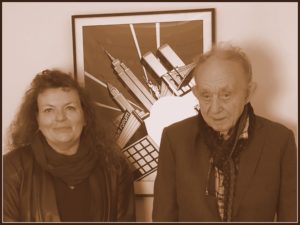Susan Kouguell speaks with Can You Ever Forgive Me? editor Anne McCabe about her collaboration with director Marielle Heller.
Click to tweet this interview to your friends and followers!
About Anne McCabe
Anne McCabe, editor, started in the cutting rooms of Woody Allen, Brian de Palma and Sidney Lumet. She has collaborated with Director Greg Mottola on several projects, including The Daytrippers, Adventureland, and the award-winning pilot for HBO’s Newsroom. She also worked closely with Kenneth Lonergan on the Academy Award-nominated film You Can Count On Me, and Margaret. Her television credits include Nurse Jackie, Damages, Younger, The Purge and this summer’s HBO’s hit drama Succession. Navigating both drama and comedy, she cut Chris Rock’s acclaimed movie Top Five and is currently editing the untitled Tom Hanks and Matthew Rhys Mr. Rogers movie, also directed by Marielle Heller.
About Can You Ever Forgive Me?
Melissa McCarthy stars as Lee Israel, the best-selling celebrity biographer (and cat lover) who made her living in the 1970’s and 80’s profiling the likes of Katharine Hepburn, Tallulah Bankhead, Estée Lauder and journalist Dorothy Kilgallen. When Lee found herself unable to get published because she had fallen out of step with the marketplace, she turned her art form to deception, abetted by her loyal friend Jack (Richard E. Grant).
THE INTERVIEW
I spoke with Anne McCabe by phone for our interview; it was certainly fortuitous timing as McCabe was in the editing room working on her next project with director Marielle Heller on the new (untitled) Tom Hanks film about Mr. Rogers.
Kouguell: Tell me about your collaboration process with Marielle Heller.
McCabe: I was drawn to project because it was a different type of story than we usually see. As an editor I’m told, ‘Can you make this woman more likeable? Does she have to do this terrible thing?’ It was wonderful to work with Mari who was unafraid to make Lee Israel super grouchy, correct people’s grammar, and so on. Lee was a difficult person and not a typical character you often see on film.
Mari is drawn to stories we haven’t seen a million times; even the character of Jack is not one we normally see. Often, we see an English character who is more informed, for example, but Jack is shallow and Lee is smarter than he is.
Interview: I, Tonya Editor Tatiana S. Riegel
Kouguell: How long was the editing process?
McCabe: About 8-9 months.
Kouguell: Did you refer directly to the shooting script?
McCabe: Absolutely. Several people spent an enormous amount of time writing this script, and I try to create as close to it as possible. Occasionally on set lines might drop, but very much what was written, is on the screen.
Before we started shooting we talked about the script, and while Mari was shooting we would discuss scenes, and the story beats. We stayed as close to the script as possible in the first cut of the movie. We did spend a lot of time reshaping the film while staying true to the story.
Kouguell: Were you cutting as they were shooting?
McCabe: Yes. I would cut the dailies the next day. Continuity was often a challenge because they were shooting in New York and there was so much changing weather.
Kouguell: You’ve worked across all genres. Tell me what made this experience unique.
McCabe: It was great to work with a lot of women who are clever and confident. I love that Mari is bold and taking chances. I worked with producer Anne Carey before on Adventureland. Mari and I had a great connection. It was great to also work with Jane Curtain and Anna Deveare Smith.
Jane Campion Talks Top of the Lake, The Piano, Writing and Moviemaking
Kouguell: Let’s talk about your reaction to McCarthy’s dramatic performance.
McCabe: Melissa Mccarthy was fabulous – she’s a beautiful woman in real life, she embraced the ‘not-looking-gorgeous’ in this role. The film starts with a close-up and they put makeup on her to make her look worse, it was a brave thing. Even the cat crap under her bed, she dove in. She embraced this grouchy, difficult person. Lee Israel is complicated, and McCarthy has so much warmth that she brought to the character.
Kouguell: Some final thoughts about the film?
McCabe: I love the fact that the film centers on two gay characters but it’s not a central theme. It’s looming, regarding the AIDS in New York City during this time period. That last scene I was most proud of. We worked hard on that. There were a lot of ways to go. The moment Lee really becomes honest and goes through all the different stages of a relationship. They’re uneasy, there’s humor, sadness. Their lives are so lonely, everyone can relate to that feeling of ‘you don’t fit in.’ Lee gets ignored because people often don’t acknowledge women in their fifties, and it’s the same for Jack. And for each of them, finding that friend.


























 Rodriguez: The film opened in September 2016 in a limited theatrical run, playing eight weeks in Palm Springs and eight weeks at The Villages in Florida. We played in Orange County, Arizona and around Florida. Little by little, it’s kept going. We are finishing our theatrical run March 30.
Rodriguez: The film opened in September 2016 in a limited theatrical run, playing eight weeks in Palm Springs and eight weeks at The Villages in Florida. We played in Orange County, Arizona and around Florida. Little by little, it’s kept going. We are finishing our theatrical run March 30.

 Kouguell: We’ve spoken a great deal about your love of collaboration. Your Podcast ‘The Director’s Chair’ available on iTunes, has welcomed writers, producers, directors, and actors, including Jessica Jones star Krysten Ritter, to discuss collaborating.
Kouguell: We’ve spoken a great deal about your love of collaboration. Your Podcast ‘The Director’s Chair’ available on iTunes, has welcomed writers, producers, directors, and actors, including Jessica Jones star Krysten Ritter, to discuss collaborating.







